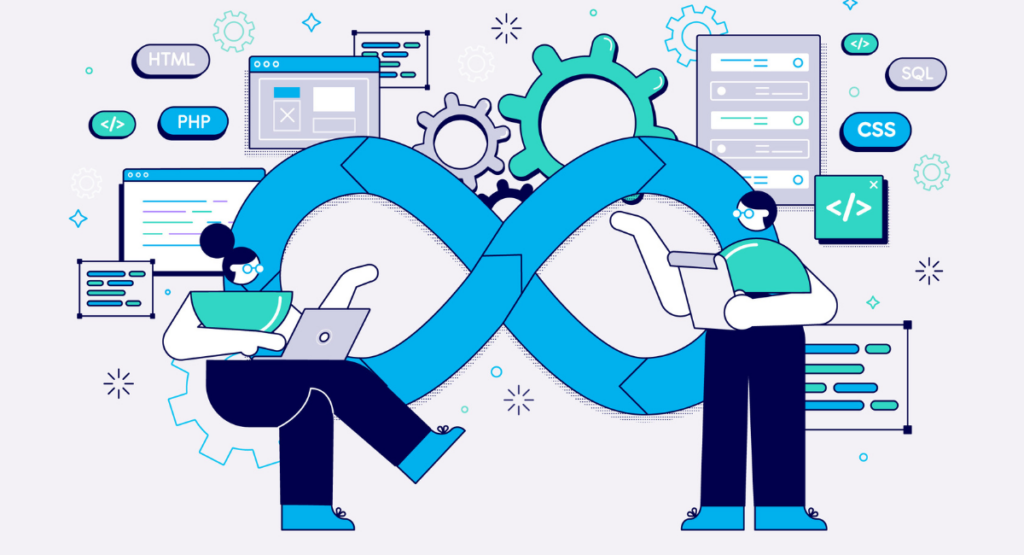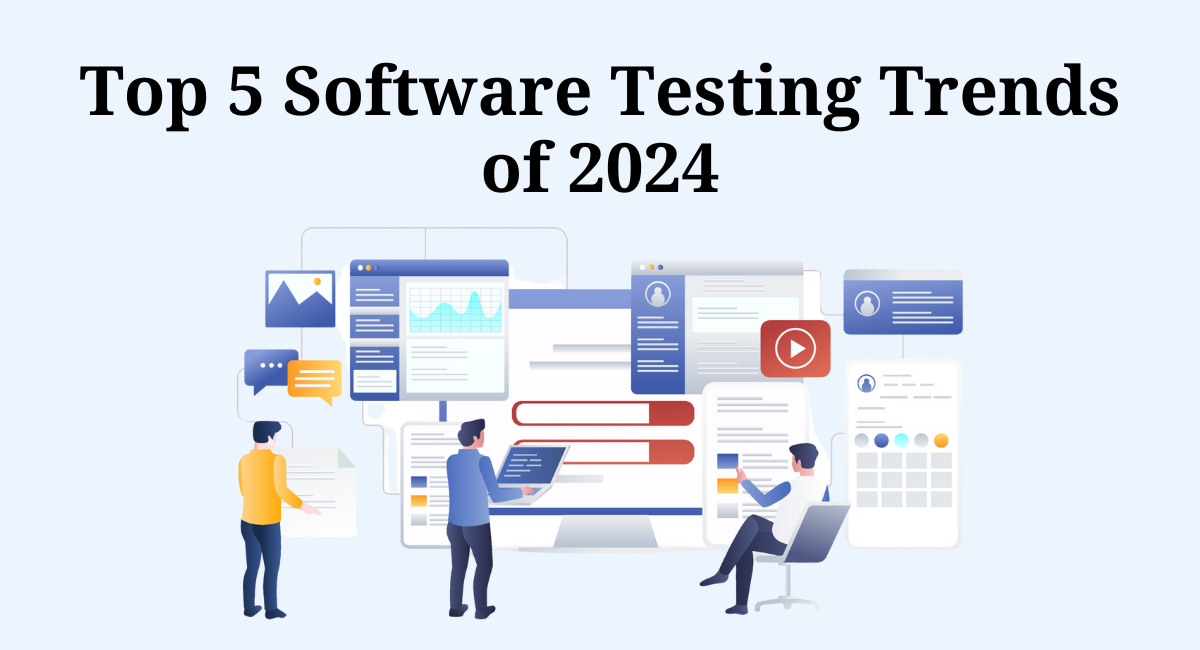As we move towards 2024 various key software testing trends are emerging that could transform this quality assurance (QA) environment significantly.
These changes will not only improve the effectiveness and efficiency of testing, but they are also in line with the larger shift toward automation, artificial Intelligence (AI), and more agile methods in the development of software.
Knowing these software testing trends is vital in the eyes of QA professionals and companies looking to improve their testing strategies to make sure that they are delivering high-quality software products in a complicated digital world.
In this article, we explore the top five software testing trends for 2024. We also provide a glimpse of how these trends can affect how we approach the next phase of QA.
Software Testing Trends of 2024

Automation
The software testing landscape is changing with the advent of automation, which is a huge change from traditional manual methods that are labor-intensive and susceptible to human errors.
Automation, which makes use of tools and technology to perform automated tests on software programs before they go into production been identified as a key trend promising reliability and efficiency.
The impact of automation on software testing
Automation has greatly impacted software testing, speeding up the testing process, improving the quality of test results, as well as allowing the ability to run complicated test scenarios that would be difficult or impossible to execute manual testing.
This has led to continuous integration as well as continuous delivery (CI/CD) pipelines, which allows for rapid software release cycles without compromising quality.
Automated testing's capability to run tests continuously has significantly reduced downtime and speeded feedback loops, which allows teams to resolve problems faster.
The advantages and disadvantages of automated testing
The benefits of automated tests are numerous. It increases the coverage of tests and increases accuracy by reducing human error it also saves time and money over the long term, and can be used with CI/CD as well as DevOps methods, making it essential in today's fast-paced Software development environments.
But it's not without its challenges. The initial setup costs selecting the best tools that are compatible with the project specifications and maintaining test scripts to adapt to modifications to the application could be a daunting task.
In addition, you need a specific amount of expertise and skill to create and implement efficient automated strategies.
Artificial Intelligence (AI) Integration
The introduction of AI for software testing will be a game changer and promises to revolutionize the field by creating smarter, more efficient methods to identify and correct errors.
AI's use in testing software extends beyond predictive analysis to the generation of test cases by automating tasks that are traditionally difficult and demanding.
AI's role AI in the testing of software
AI improves software testing by enabling smart automated testing, which can adapt and learn in time, increasing its effectiveness with each test.
AI algorithms can analyze the data from applications, identify the possibility of problems, and suggest appropriate tests. The ability to anticipate and fix defects before they are even discovered can dramatically enhance the quality of software and its durability.
AI-powered tools to speed up testing procedures
A variety of AI-powered tools have come out that streamline the process of testing. These tools automate the production of test scenarios, run tests, and then learn from test outcomes to help improve future tests.
Software that employs machine learning algorithms can analyze test results from the past to find patterns, predict results, and drastically reduce the time and effort needed for manual testing and test execution.
This not only speeds up the development process but also increases the level of quality for the product that is created.
The potential drawbacks of AI integration into testing
Although AI integration into software testing has enormous possibilities, it has some hurdles to overcome. The dependence on the quality of data and the need for huge data sets to create AI models are major obstacles.
There's also the possibility that AI algorithms could overlook subtleties that human testers might detect. Additionally, testers must have the necessary capabilities to successfully utilize and interact with AI-based tools for testing that require regular learning and training.
Despite these obstacles, AI's advantages in testing software are significant and will lead to a future in which testing will be more reliable and automated. It will also be more efficient.
Shift-Left Test Method
Explanation of Shift-Left Test
Shift-Left testing is an approach used in the development of software that focuses on testing early, and often during the development process.
In contrast to waiting until the product is near completion to conduct rigorous testing, shift left testing incorporates testing procedures at the beginning of development.
This process involves developers, quality control (QA) teams and all involved in a cooperative effort to correct and address problems when they first become apparent.
The phrase "shift-left" is used to describe the process of moving testing to the left on the timeline of the project, where the left-hand side represents the beginning phases of development.
Benefits of using Shift-Left Testing in Software Development
Testing with Shift-Left brings many benefits to software development projects for example:
Improved Quality:
By identifying and fixing issues early in the development process the overall quality of the software is improved. Early detection lets teams tackle issues before they turn into complicated issues.
Cost reduction:
A defect that is discovered early is usually less expensive to repair than those found later in the process of development or even after the release. This could significantly lower the overall cost of the project.
Speedier time to market:
Effective and early testing accelerates the process of development by decreasing the amount of time needed for revisions. This may lead to faster release of products without compromising quality.
Improved Collaboration:
Shift Left testing encourages greater collaboration between developers, stakeholders, and testers and leads to an improved development team and higher-quality end products.
Continuous Testing

Continuous Testing is essential to be a part of Agile or DevOps environments since it guarantees that software can be released promptly at any time.
It is the automated running of a set of tests throughout the various phases of the development process, giving teams immediate feedback regarding the business risks that accompany the release of software.
This method of testing is essential to maintain high quality in an environment of rapid development which is subject to frequent changes as well as the speed of the market a crucial competitive advantage.
Tools and techniques for successful Continuous Testing
To implement continuous testing efficiently teams employ a range of techniques and tools, for example:
Automated Testing Tools:
Tools like Selenium, Jenkins, and CircleCI enable the automation of testing processes, making it easier to integrate testing into the continuous integration/continuous deployment (CI/CD) pipeline.
System for Version Control:
The use of systems such as Git lets teams manage changes and ensure that tests are carried out with the most up-to-date versions of software.
Test-Driven Development (TDD):
The practice helps developers write tests before writing the code to implement the function. TDD assists in ensuring that testing is a crucial part of the design process.
Virtualization and Containerization:
Technologies such as Docker and Kubernetes enable the creation of uniform test environments that can rapidly spin up and down, eliminating the need for differences between production and testing environments.
Continuous testing in the development process increases the efficacy, reliability as well as quality of software which makes it an essential advancement in the ever-changing world of software tests.
Test Data Management Strategies
The management of test data (TDM) has become an essential element to ensure thorough and effective tests using software. As companies navigate the challenges that are digitally changing, the importance of TDM is more important than ever.
The effective control of test data does not just improve the quality of testing but also reduces cost and time making it easier to create a more agile and flexible software development lifecycle.
Importance of a successful management of test data
The importance of well-organized test data management is its ability to create safe and authentic environments for test purposes.
With the increasing emphasis placed on the security of data and privacy laws, like GDPR and CCPA and CCPA, the requirement for properly-managed test data has increased.
High-quality test data aids in detecting defects earlier, which impacts how much it costs to fix bugs, cutting down on the cost. A
Additionally, it helps with the compliance of regulatory agencies by making sure the test results are secure and safe, thus protecting sensitive information from being exposed.
Best techniques for testing data generation and maintenance
Implementing the best practices for the generation of test data and its maintenance is vital to harnessing all the potential TDM strategies.
The best practices include:
Automation of Test Data Generation:
Automation helps to create quality test data quickly and efficiently, thereby significantly cutting down on manual errors and time.
Implementing Data Masking Data masking is essential to safeguard sensitive information while preserving the accuracy of data used for testing and ensuring compliance with data protection laws.
Making use of Testing Data Management Tools:
Leveraging TDM tools can simplify the processes involved in testing data creation, maintenance, and removal, making it simpler to monitor the duration of the lifecycle of the test information.
Regularly refreshing test data Regular updates guarantee that test results are relevant and are based on real-world scenarios increasing the credibility of test results.
Ensure Data Accessibility, as well as Accessibility, including ensuring test results are accessible and available to the right teams at the appropriate time while also optimizing workflows for testing.
By integrating these methods into your TDM strategies, companies can achieve more accurate test results, adhere to regulations for protecting data, and accelerate the testing process while ensuring the integrity of the data and security.
Book a Demo and experience ContextQA testing tool in action with a complimentary, no-obligation session tailored to your business needs.
Conclusion
The world of testing software is changing quickly, shaped by technological advances and growing demands for greater quality and efficiencies in the development of software.
The top five trends in testing software for 2024 show a shift toward an intelligent automation process, the use of AI as well as ML in testing, the increasing importance of DevSecOps as well as the increased use of cloud-based testing platforms, and the increasing importance of test for Internet of Things (IoT).
These developments signal a change within the QA process, from the traditional manual-centric approach to one that's more fluid automated, automated, and fully connected to the entire operational and development workflows.
In embracing these new trends, companies can not only improve their testing procedures but also ensure that their products are safe and reliable and adapt to the changing requirements of customers in the age of digital.
As we progress staying on top of these advancements and including them in QA strategies is crucial to ensuring competitiveness and success in the field of software.
You may also Interested in SXSW Events for Software Development
We make it easy to get started with the ContextQA tool: Start Free Trial.
